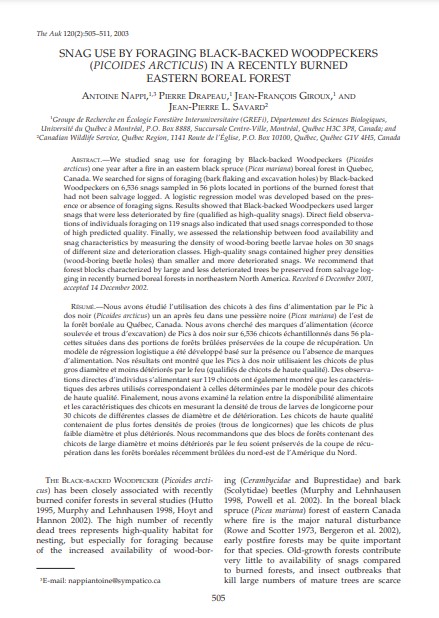Snag Use By Foraging Black-Backed Woodpeckers (Picoides Arcticus) in a Recently Burned Eastern Boreal Forest
Bosque Modelo:
Lake Abitibi
Temática:
Gestión forestal
Tipo de documento:
Artículo científico
Resumen
We studied snag use for foraging by Black-backed Woodpeckers (Picoides arcticus) one year after a fire in an eastern black spruce (Picea mariana) boreal forest in Quebec, Canada. We searched for signs of foraging (bark fl aking and excavation holes) by Black-backed Woodpeckers on 6,536 snags sampled in 56 plots located in portions of the burned forest that had not been salvage logged. A logistic regression model was developed based on the presence or absence of foraging signs. Results showed that Black-backed Woodpeckers used larger snags that were less deteriorated by fi re (qualifi ed as high-quality snags). Direct fi eld observations of individuals foraging on 119 snags also indicated that used snags corresponded to those of high predicted quality. Finally, we assessed the relationship between food availability and snag characteristics by measuring the density of wood-boring beetle larvae holes on 30 snags of different size and deterioration classes. High-quality snags contained higher prey densities (wood-boring beetle holes) than smaller and more deteriorated snags. We recommend that forest blocks characterized by large and less deteriorated trees be preserved from salvage logging in recently burned boreal forests in northeastern North America
Información Bibliográfica
Autor:
Nappi, A, P Drapeau, J-F Giroux, J-P Savard.
Revista:
The Auk
Año:
2003
N°:
2
País :
Canadá
Páginas:
505 - 511
Volumen:
120
Idioma:
Ingles
Palabras claves
Forest floor; Boreal; snag; Woodpeckers; Picoides Arcticus





